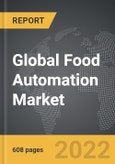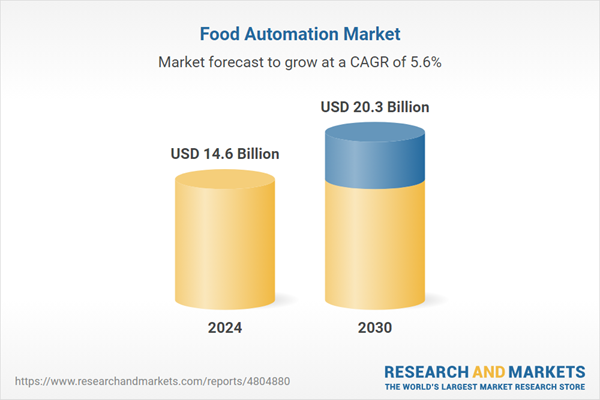Global Food Automation Market - Key Trends & Drivers Summarized
Food automation encompasses the use of advanced technology and machinery to streamline and enhance various processes within the food and beverage industry. This includes everything from food production, processing, and packaging to distribution and inventory management. Automated systems help in performing repetitive and labor-intensive tasks with higher precision, speed, and consistency compared to manual labor. Robotics, conveyor systems, automated guided vehicles (AGVs), and advanced sensors are some of the key components in food automation. These technologies not only improve efficiency but also maintain higher hygiene standards by minimizing human contact with food products. In processing plants, automation is crucial for tasks such as sorting, slicing, mixing, and cooking, ensuring that food products meet stringent quality and safety standards.Technological advancements have significantly bolstered the capabilities of food automation systems. Integration of artificial intelligence (AI) and machine learning enables these systems to adapt to changing conditions and optimize processes in real time. For instance, AI-driven quality control systems can detect defects in products with greater accuracy than human inspectors, ensuring only the best products reach the market. The Internet of Things (IoT) allows for seamless connectivity and data exchange between various pieces of equipment, facilitating better coordination and tracking throughout the production line. Additionally, developments in robotics have led to more flexible and multifunctional machines that can be easily reprogrammed to handle different tasks. These innovations have also led to the creation of smart packaging solutions that enhance product traceability and shelf life, further driving the efficiency and reliability of the food supply chain.
The growth in the food automation market is driven by several factors, reflecting the evolving needs and technological advancements within the food industry. One significant driver is the increasing demand for processed and packaged foods, fueled by changing consumer lifestyles and preferences for convenience. The rising concerns about food safety and quality control have also propelled the adoption of automation, as these systems provide more consistent and reliable outcomes. Labor shortages and the need for cost reduction in production processes are other critical factors encouraging the shift towards automated solutions. Furthermore, the push for sustainability and waste reduction in the food industry drives the development of automation technologies that minimize resource usage and enhance efficiency. The ongoing advancements in AI, robotics, and IoT are continuously expanding the capabilities and applications of food automation systems, making them more accessible and effective for food manufacturers. These factors collectively ensure the robust growth and continuous innovation in the food automation market, shaping the future of food production and processing.
Report Scope
The report analyzes the Food Automation market, presented in terms of market value (USD). The analysis covers the key segments and geographic regions outlined below.- Segments: Type (Motors & Generators, Discrete Controllers & Visualization, Rotary Products, Linear Products, Other Types); Function (Packaging & Repackaging, Sorting & Grading, Picking & Placing, Processing, Palletizing, Other Functions); Application (Beverages; Meat, Poultry & Seafood; Fruits & Vegetables; Bakery; Dairy; Other Applications).
- Geographic Regions/Countries: World; USA; Canada; Japan; China; Europe; France; Germany; Italy; UK; Spain; Russia; Rest of Europe; Asia-Pacific; Australia; India; South Korea; Rest of Asia-Pacific; Latin America; Argentina; Brazil; Mexico; Rest of Latin America; Middle East; Iran; Israel; Saudi Arabia; UAE; Rest of Middle East; Africa.
Key Insights:
- Market Growth: Understand the significant growth trajectory of the Packaging & Repackaging Function segment, which is expected to reach US$8 Billion by 2030 with a CAGR of 6.8%. The Sorting & Grading Function segment is also set to grow at 5.2% CAGR over the analysis period.
- Regional Analysis: Gain insights into the U.S. market, valued at $3.1 Billion in 2024, and China, forecasted to grow at an impressive 7.5% CAGR to reach $2.1 Billion by 2030. Discover growth trends in other key regions, including Japan, Canada, Germany, and the Asia-Pacific.
Why You Should Buy This Report:
- Detailed Market Analysis: Access a thorough analysis of the Global Food Automation Market, covering all major geographic regions and market segments.
- Competitive Insights: Get an overview of the competitive landscape, including the market presence of major players across different geographies.
- Future Trends and Drivers: Understand the key trends and drivers shaping the future of the Global Food Automation Market.
- Actionable Insights: Benefit from actionable insights that can help you identify new revenue opportunities and make strategic business decisions.
Key Questions Answered:
- How is the Global Food Automation Market expected to evolve by 2030?
- What are the main drivers and restraints affecting the market?
- Which market segments will grow the most over the forecast period?
- How will market shares for different regions and segments change by 2030?
- Who are the leading players in the market, and what are their prospects?
Report Features:
- Comprehensive Market Data: Independent analysis of annual sales and market forecasts in US$ Million from 2024 to 2030.
- In-Depth Regional Analysis: Detailed insights into key markets, including the U.S., China, Japan, Canada, Europe, Asia-Pacific, Latin America, Middle East, and Africa.
- Company Profiles: Coverage of players such as ABB Ltd., DESTACO, Emerson Electric Co., Falcon Autotech Pvt Ltd., Food Automation Pty. Ltd. and more.
- Complimentary Updates: Receive free report updates for one year to keep you informed of the latest market developments.
Some of the 118 companies featured in this Food Automation market report include:
- ABB Ltd.
- DESTACO
- Emerson Electric Co.
- Falcon Autotech Pvt Ltd.
- Food Automation Pty. Ltd.
- GEA Group Aktiengesellschaft
- Honeywell International Inc.
- JLS Automation
- NORD Drivesystems Pvt. Ltd.
- ProLeiT GmbH
- REGAL REXNORD CORPORATION
- Rockwell Automation, Inc.
- Schneider Electric SE
- Siemens Aktiengesellschaft
- Yaskawa Electric Corporation
- Yokogawa Electric Corporation
This edition integrates the latest global trade and economic shifts into comprehensive market analysis. Key updates include:
- Tariff and Trade Impact: Insights into global tariff negotiations across 180+ countries, with analysis of supply chain turbulence, sourcing disruptions, and geographic realignment. Special focus on 2025 as a pivotal year for trade tensions, including updated perspectives on the Trump-era tariffs.
- Adjusted Forecasts and Analytics: Revised global and regional market forecasts through 2030, incorporating tariff effects, economic uncertainty, and structural changes in globalization. Includes historical analysis from 2015 to 2023.
- Strategic Market Dynamics: Evaluation of revised market prospects, regional outlooks, and key economic indicators such as population and urbanization trends.
- Innovation & Technology Trends: Latest developments in product and process innovation, emerging technologies, and key industry drivers shaping the competitive landscape.
- Competitive Intelligence: Updated global market share estimates for 2025, competitive positioning of major players (Strong/Active/Niche/Trivial), and refined focus on leading global brands and core players.
- Expert Insight & Commentary: Strategic analysis from economists, trade experts, and domain specialists to contextualize market shifts and identify emerging opportunities.
Table of Contents
Companies Mentioned (Partial List)
A selection of companies mentioned in this report includes, but is not limited to:
- ABB Ltd.
- DESTACO
- Emerson Electric Co.
- Falcon Autotech Pvt Ltd.
- Food Automation Pty. Ltd.
- GEA Group Aktiengesellschaft
- Honeywell International Inc.
- JLS Automation
- NORD Drivesystems Pvt. Ltd.
- ProLeiT GmbH
- REGAL REXNORD CORPORATION
- Rockwell Automation, Inc.
- Schneider Electric SE
- Siemens Aktiengesellschaft
- Yaskawa Electric Corporation
- Yokogawa Electric Corporation
Table Information
| Report Attribute | Details |
|---|---|
| No. of Pages | 608 |
| Published | October 2025 |
| Forecast Period | 2024 - 2030 |
| Estimated Market Value ( USD | $ 14.6 Billion |
| Forecasted Market Value ( USD | $ 20.3 Billion |
| Compound Annual Growth Rate | 5.6% |
| Regions Covered | Global |









